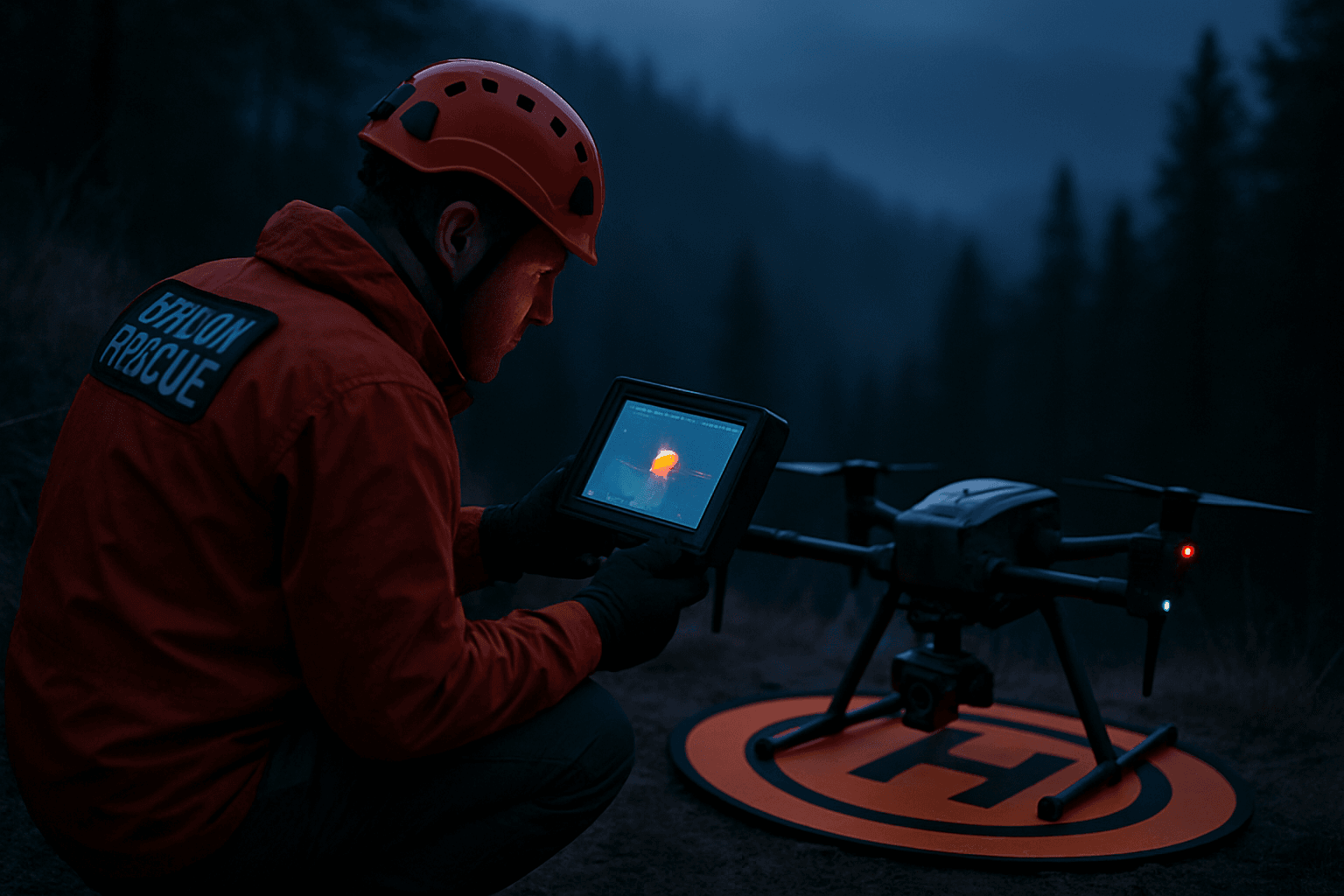Drones equipped with advanced thermal imaging capabilities are transforming search and rescue (SAR) operations, offering a critical advantage in detecting faint heat signatures, even in the most challenging environments. These Unmanned Aerial Systems (UAS) provide a rapid, aerial perspective that significantly enhances the ability to locate missing persons, often in conditions where traditional search methods are limited or impossible.
The Imperative of Thermal Imaging in SAR
In SAR missions, every second counts. Traditional ground searches are often slow, labor-intensive, and hazardous, particularly in vast, rugged, or low-visibility areas. Drones overcome many of these limitations by providing an elevated viewpoint and the ability to cover expansive territories quickly. The integration of thermal imaging cameras, also known as Forward-Looking Infrared (FLIR) cameras, is a game-changer, allowing rescuers to “see” heat emitted by objects and individuals, irrespective of ambient light. This capability is invaluable during nighttime operations, in dense foliage, through smoke, or even under light debris, where a person might be otherwise invisible to the naked eye or standard cameras.
The Science of Faint Heat Signature Detection
Thermal imaging operates within the infrared spectrum, specifically capturing wavelengths between 8,000 and 14,000 nanometers, which correspond to heat emissions. Unlike night vision, which amplifies ambient light, thermal imaging relies solely on temperature differences, making it effective in total darkness or conditions with no visible light.
Infrared Thermography Principles
A human body emits heat at approximately 98.6°F (37°C). Thermal sensors can distinguish this heat signature from cooler backgrounds, translating heat levels into visual gradients. The thermal camera on a drone picks up these infrared signals and converts them into a “heat map” that depicts the temperature distribution of the landscape or objects below. This allows a missing person’s body heat to stand out against colder surroundings like a forest floor or rocky terrain.
Factors Affecting Heat Signature Detection
Several factors influence the effectiveness of faint heat signature detection:
- Temperature Difference: The most critical parameter is the temperature difference between the target and its environment. A larger difference results in a clearer heat signature.
- Emissivity: Different materials emit infrared radiation differently. Understanding the emissivity of various surfaces helps distinguish between a human heat signature and other heat sources like warm rocks or animal bodies. While animal bodies can be a confounding factor, digital image processing often aids in distinguishing shapes.
- Distance and Resolution: The drone’s altitude and the thermal sensor’s resolution significantly impact detection capabilities. Higher resolution (640×512 or higher) allows for clearer images, especially at greater altitudes or when scanning large areas. Typically, a 640×512 sensor can detect human-sized heat signatures from 150-200 feet Above Ground Level (AGL).
- Environmental Obstacles: Dense foliage, water, fog, and smoke can attenuate infrared signals, making detection more challenging. However, thermal imaging can still penetrate smoke, dust, haze, and light foliage, unlike visible light cameras.
Specialized Drone Technologies for Enhanced Detection
Modern SAR drones integrate a suite of advanced technologies to maximize their ability to detect faint heat signatures in demanding conditions.
High-Sensitivity Thermal Sensors
High-sensitivity thermal sensors are crucial for detecting subtle temperature differences. Key specifications include:
- Resolution: Higher thermal resolution, such as 640×512 or 1280×1024, provides clearer and more detailed heat signature images.
- Thermal Sensitivity (NETD): Net Emissivity Difference Temperature (NETD) measures a sensor’s ability to detect minute temperature variations. A lower NETD value (e.g., ≤50 mK or better than 0.05°C) indicates higher sensitivity, allowing the detection of even faint heat differences.
- Frame Rate: A higher frame rate (30Hz+) ensures a smooth video feed, reducing lag during live search operations.
Multi-Spectral and Hyperspectral Imaging Integration
While thermal imaging provides heat signatures, multispectral and hyperspectral cameras offer additional layers of information.
- Multispectral Imaging: Captures data across multiple bands of the electromagnetic spectrum, including visible light, near-infrared (NIR), and red edge. This can provide deeper insights into environmental conditions and help differentiate targets.
- Hyperspectral Imaging: Offers even narrower and more numerous spectral bands than multispectral, allowing for more detailed analysis and the ability to detect targets that might be disguised or obscured. These systems can even surveil underwater targets.
The combination of thermal and visual light cameras, as seen in systems like Teledyne FLIR’s SIRAS, allows for dual-camera systems that provide both heat signatures and visual context. FLIR’s MSX® technology, for example, overlays visible light details onto thermal images, helping rescuers differentiate between false positives (like animal heat signatures) and genuine human targets.
Advanced Image Processing and AI Algorithms
Artificial intelligence (AI) and machine learning (ML) are significantly enhancing the capabilities of thermal drones in SAR.
- Object Detection and Recognition: AI algorithms, particularly Deep Learning models like Convolutional Neural Networks (CNNs) and You-Only-Look-Once (YOLO), are trained on vast datasets of thermal images to recognize human heat signatures even in complex backgrounds, cluttered environments, or when partially occluded.
- Real-time Analysis: AI enables real-time processing of thermal images, allowing immediate analysis and decision-making crucial in time-sensitive SAR operations. Some systems process footage after a search, while others analyze images in real-time on the drone controller.
- Noise Filtering and False Positive Reduction: AI algorithms can filter out noise and irrelevant data, distinguishing human heat signatures from other heat sources (fires, animals, machinery) to reduce false positives and improve detection accuracy.
- Automated Search Patterns and Navigation: AI enables drones to navigate autonomously, avoiding obstacles and adapting to changing environments. This allows SAR teams to focus on data interpretation rather than constant piloting. AI-powered algorithms like Simultaneous Localisation And Mapping (SLAM) allow drones to create real-time maps and navigate accurately even in GPS-denied environments like dense forests or urban canyons.
Gimbal Stabilization and Zoom Capabilities
High-performance gimbals with continuous stabilization are essential for maintaining clear imagery, especially during drone movement or in windy conditions. Optical zoom capabilities allow for detailed inspection of potential targets from a safe distance, without compromising image clarity, while digital zoom further enhances this.
Overcoming Challenging SAR Environments
Challenging environments often pose significant hurdles for SAR operations. Drones with advanced thermal capabilities are designed to mitigate these difficulties.
Environmental Obstacles
- Foliage: Dense forests and thick underbrush can obscure a missing person from ground view. Thermal cameras can penetrate light foliage to detect heat signatures.
- Water: In maritime SAR, thermal drones can assist in locating individuals at sea by detecting their heat signatures against cooler water. However, the low contrast between a person and water, especially as hypothermia sets in, presents a challenge that ongoing research aims to improve.
- Fog and Smoke: Unlike visible light, thermal imaging can “see” through smoke, heavy fog, and even dust, making it invaluable in fire zones or other low-visibility conditions.
- Rubble and Debris: After natural disasters, drones with thermal sensors can detect heat signatures from individuals trapped under rubble or in collapsed buildings.
Weather Conditions
- Night Operations: Thermal drones are highly effective for nighttime searches, enabling operations to continue effectively in total darkness.
- Extreme Temperatures: Thermal cameras need to maintain accuracy across a range of operating temperatures. Drones and their payloads are often designed to withstand harsh weather, including cold or hot conditions.
- Rain and Snow: While extreme weather can hinder drone performance, protective housings and advanced calibration techniques can help maintain accuracy.
Terrain Complexity
- Mountains and Rugged Terrain: Drones can survey vast, rugged, and mountainous regions much faster than ground teams, navigating over cliffs and dense vegetation that are inaccessible to human rescuers.
- Urban Rubble: In urban disaster responses, drones can scan large areas of debris and enter confined spaces to search for survivors.
Operational Considerations and Best Practices
Maximizing the effectiveness of thermal drones in SAR requires careful operational planning and skilled deployment.
Flight Planning and Altitude Optimization
Drone flight planning software allows pre-programming flight paths, ensuring consistent coverage and data capture. Terrain-following capabilities keep the drone at a constant distance above the ground, crucial for accurate thermal mapping in uneven terrain. Optimal flight altitude depends on sensor resolution and environmental conditions; for a 640×512 sensor, human-sized signatures are typically detectable from 150-200 feet AGL.
Power Management and Endurance
Battery life remains a limitation for many electrically powered drones, restricting operational range and time. However, advancements in battery technology and the development of drone dock systems that facilitate autonomous charging are extending operational capabilities. Drones like the DJI Matrice 350 RTK offer extended flight times, while compact models like the DJI Mavic 3T are suitable for rapid response.
Data Interpretation and Training
While AI assists in data analysis, human oversight remains essential. SAR teams need training to effectively interpret thermal imagery, differentiate between potential false positives and genuine targets, and understand the nuances of thermal data. Real-time video streaming from the drone to multiple devices on the ground helps coordinate teams and provides immediate situational awareness.
Future Trends and Innovations
The field of drone technology for SAR is continually evolving, with several key trends shaping its future.
AI and Machine Learning for Automated Detection
The rise of AI-powered drones is enabling autonomous navigation, real-time object recognition, and predictive analytics. AI will increasingly automate hotspot detection, identify patterns and anomalies with greater accuracy, and even predict fire behavior or target movement based on environmental factors. This includes advanced computer vision tools that can scan images and video for unusual shapes or specific colors, further reducing human error.
Swarm Robotics and Collaborative Drones
The future will see more autonomous drone swarms working collaboratively to cover larger areas more quickly. If one drone detects a faint heat signature, nearby drones can converge to provide additional perspectives and confirmation, without direct human intervention. This collective intelligence, combined with sensor fusion (integrating data from visual, thermal, LiDAR, and GPS sensors), will provide a more comprehensive understanding of the environment.
Miniaturization and Enhanced Sensor Performance
Ongoing advancements in sensor technology are leading to smaller, lighter, and higher-resolution thermal cameras, allowing for integration into progressively smaller UAS platforms without compromising image quality. This miniaturization, combined with improved sensitivity and dynamic range, will enable even more precise detection of faint heat signatures from greater distances.
Conclusion
Drone capabilities for detecting faint heat signatures are revolutionizing search and rescue operations, providing an indispensable tool for locating individuals in challenging environments. Through high-sensitivity thermal sensors, the integration of multi-spectral and hyperspectral imaging, and the transformative power of AI-driven analytics, these UAS platforms are enhancing efficiency, reducing risks, and dramatically improving the chances of successful rescues. As technology continues to advance, the role of drones in SAR will only expand, offering even more sophisticated and autonomous solutions for critical life-saving missions.





